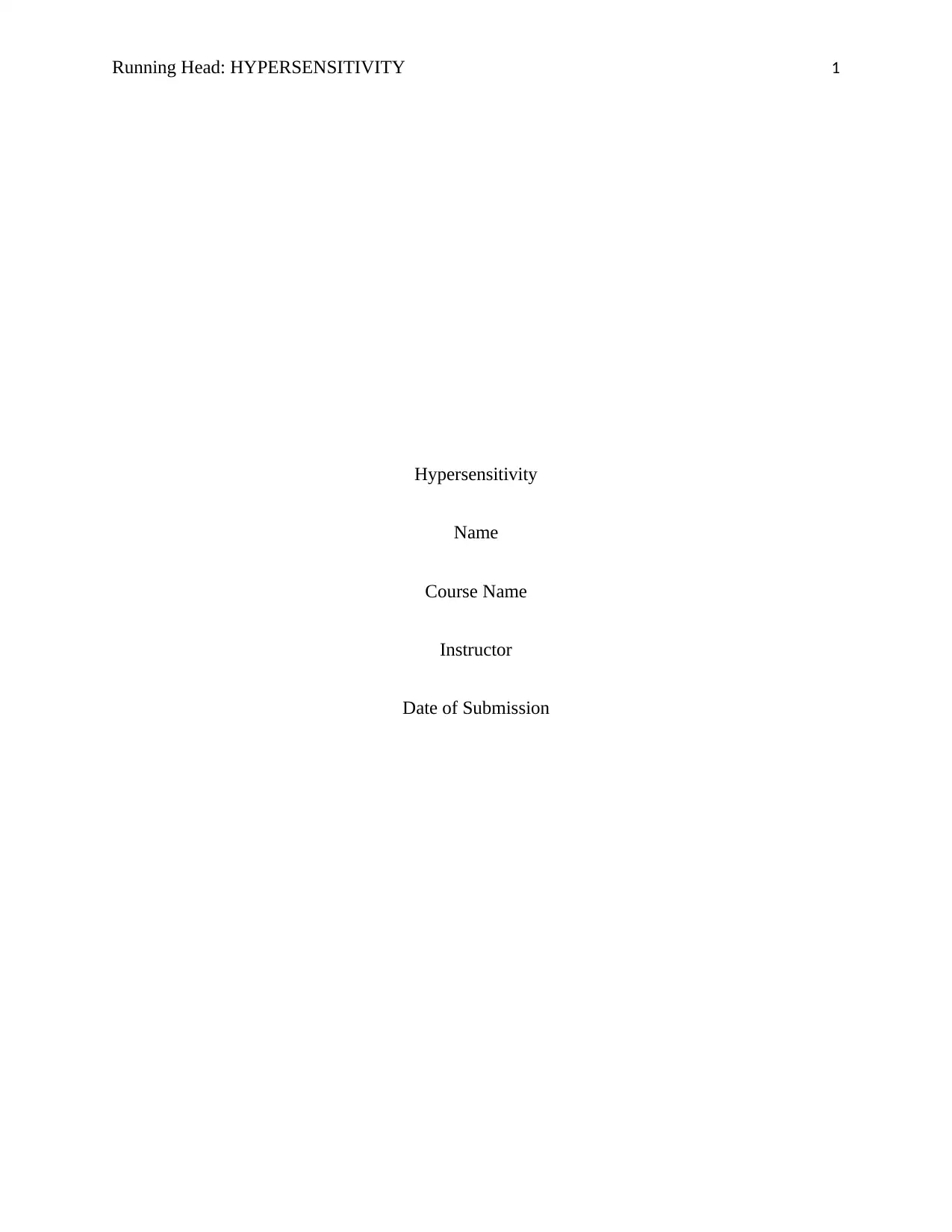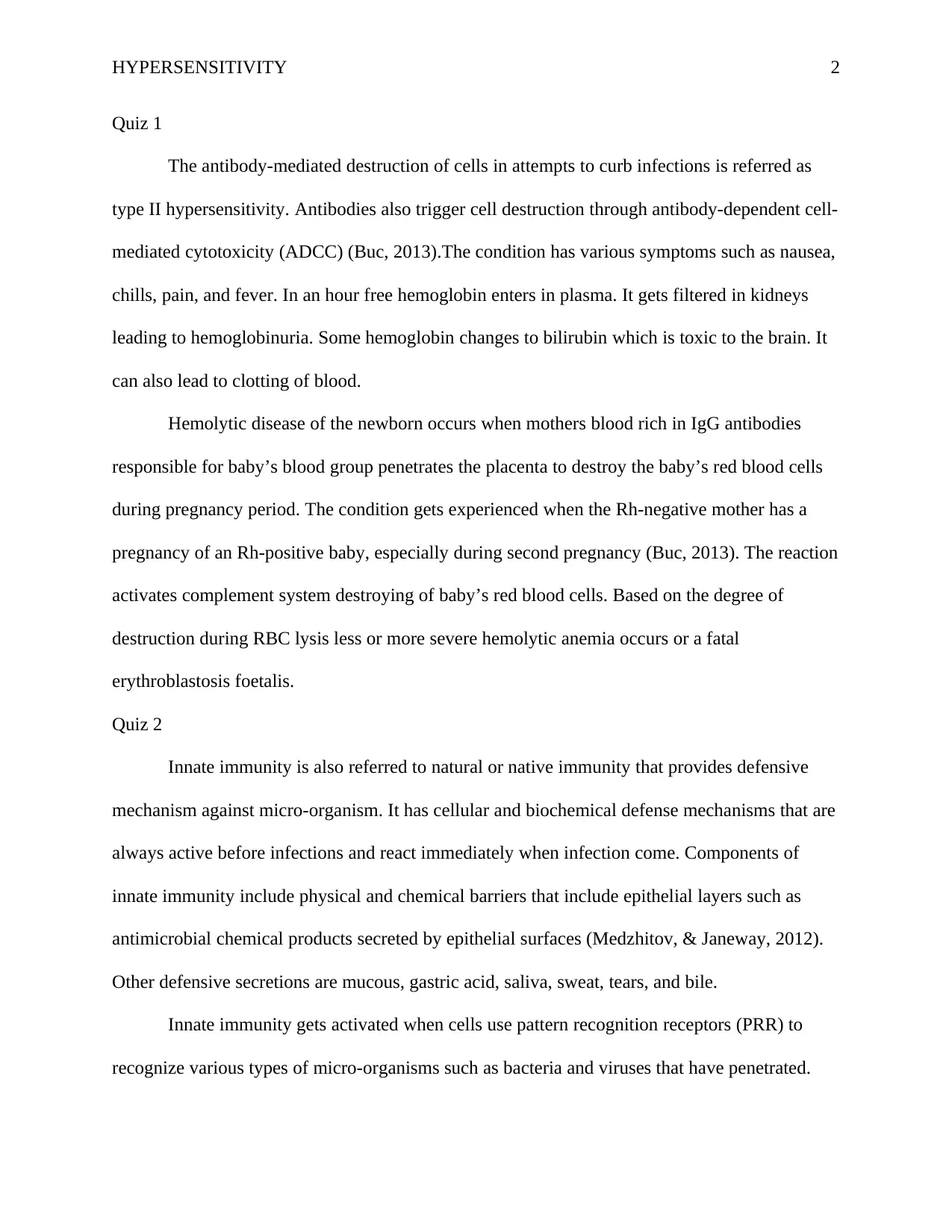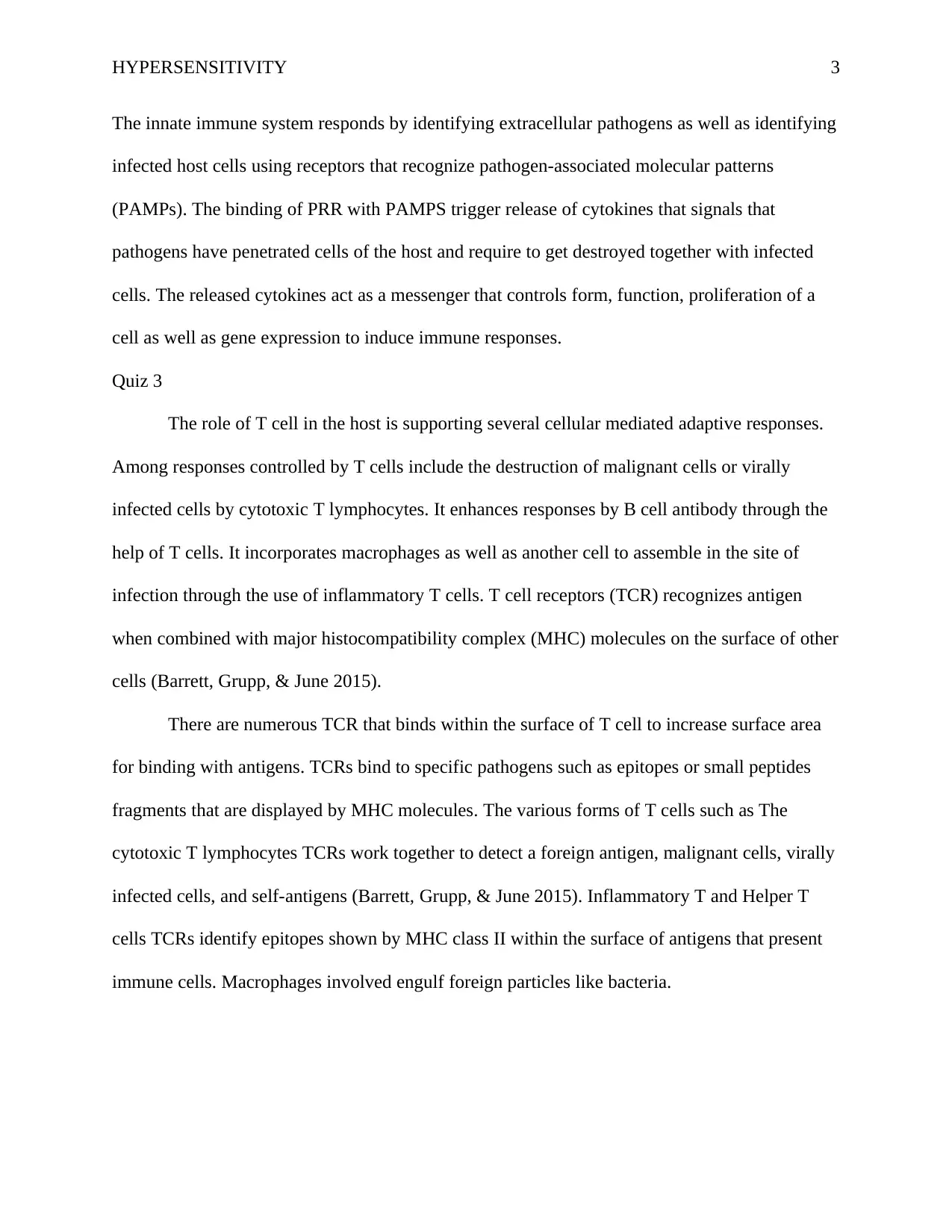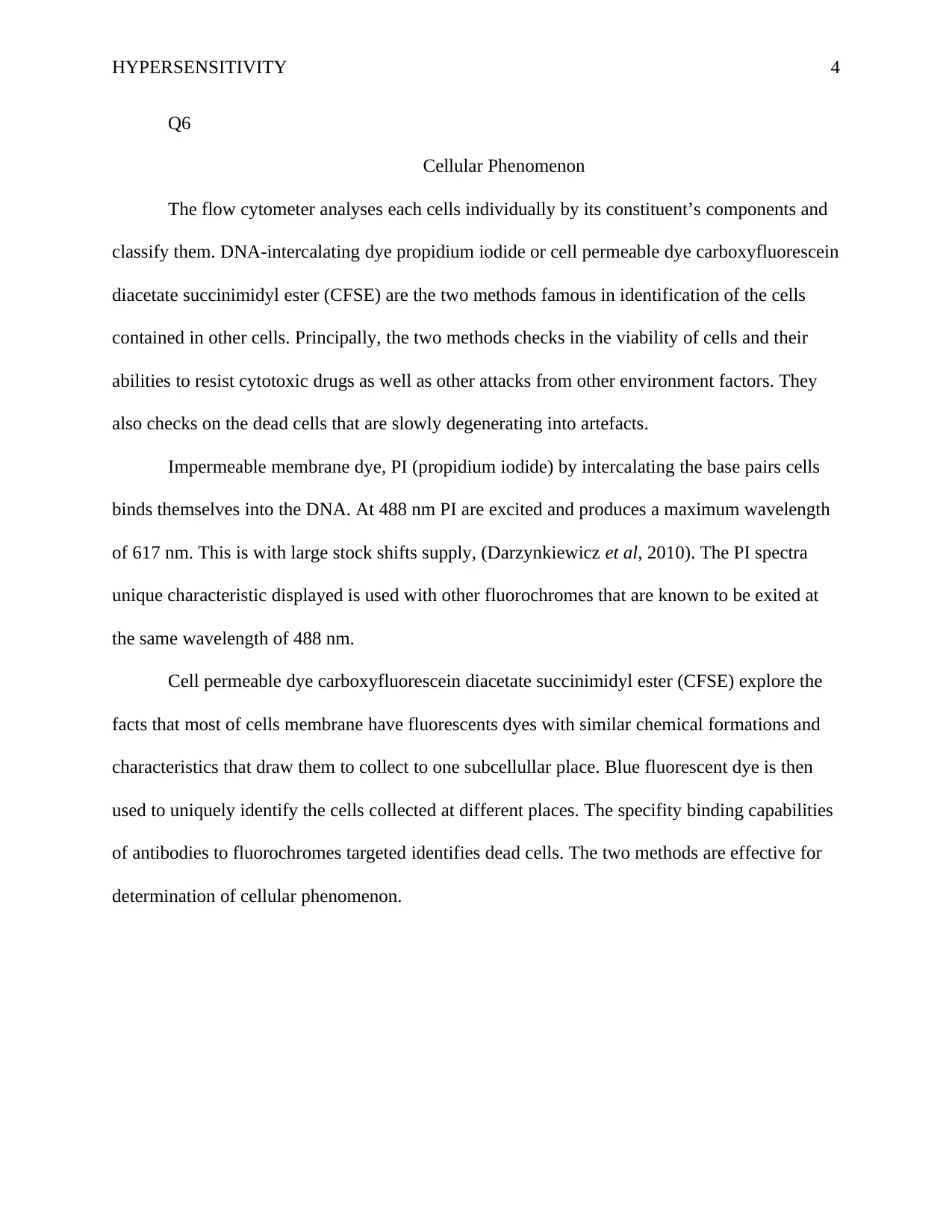Biology: Hypersensitivity Quiz - Cellular Phenomenon and Immunity
VerifiedAdded on 2023/06/03
|5
|1023
|107
Quiz and Exam
AI Summary
This document presents a biology quiz focusing on hypersensitivity, exploring various aspects of the immune system. The quiz covers type II hypersensitivity, detailing antibody-mediated cell destruction and related conditions like hemolytic disease of the newborn. It also examines innate immunity, including its cellular and biochemical defense mechanisms, such as physical and chemical barriers, and the role of pattern recognition receptors (PRRs) in identifying pathogens. Furthermore, the quiz addresses the function of T cells in adaptive immune responses, including their role in destroying infected or malignant cells and enhancing B cell antibody responses. The quiz also delves into cellular phenomena, specifically analyzing cell components using flow cytometry, including the use of DNA-intercalating dyes and cell-permeable dyes to assess cell viability and responses to cytotoxic drugs.

Running Head: HYPERSENSITIVITY 1
Hypersensitivity
Name
Course Name
Instructor
Date of Submission
Hypersensitivity
Name
Course Name
Instructor
Date of Submission
Paraphrase This Document
Need a fresh take? Get an instant paraphrase of this document with our AI Paraphraser

HYPERSENSITIVITY 2
Quiz 1
The antibody-mediated destruction of cells in attempts to curb infections is referred as
type II hypersensitivity. Antibodies also trigger cell destruction through antibody-dependent cell-
mediated cytotoxicity (ADCC) (Buc, 2013).The condition has various symptoms such as nausea,
chills, pain, and fever. In an hour free hemoglobin enters in plasma. It gets filtered in kidneys
leading to hemoglobinuria. Some hemoglobin changes to bilirubin which is toxic to the brain. It
can also lead to clotting of blood.
Hemolytic disease of the newborn occurs when mothers blood rich in IgG antibodies
responsible for baby’s blood group penetrates the placenta to destroy the baby’s red blood cells
during pregnancy period. The condition gets experienced when the Rh-negative mother has a
pregnancy of an Rh-positive baby, especially during second pregnancy (Buc, 2013). The reaction
activates complement system destroying of baby’s red blood cells. Based on the degree of
destruction during RBC lysis less or more severe hemolytic anemia occurs or a fatal
erythroblastosis foetalis.
Quiz 2
Innate immunity is also referred to natural or native immunity that provides defensive
mechanism against micro-organism. It has cellular and biochemical defense mechanisms that are
always active before infections and react immediately when infection come. Components of
innate immunity include physical and chemical barriers that include epithelial layers such as
antimicrobial chemical products secreted by epithelial surfaces (Medzhitov, & Janeway, 2012).
Other defensive secretions are mucous, gastric acid, saliva, sweat, tears, and bile.
Innate immunity gets activated when cells use pattern recognition receptors (PRR) to
recognize various types of micro-organisms such as bacteria and viruses that have penetrated.
Quiz 1
The antibody-mediated destruction of cells in attempts to curb infections is referred as
type II hypersensitivity. Antibodies also trigger cell destruction through antibody-dependent cell-
mediated cytotoxicity (ADCC) (Buc, 2013).The condition has various symptoms such as nausea,
chills, pain, and fever. In an hour free hemoglobin enters in plasma. It gets filtered in kidneys
leading to hemoglobinuria. Some hemoglobin changes to bilirubin which is toxic to the brain. It
can also lead to clotting of blood.
Hemolytic disease of the newborn occurs when mothers blood rich in IgG antibodies
responsible for baby’s blood group penetrates the placenta to destroy the baby’s red blood cells
during pregnancy period. The condition gets experienced when the Rh-negative mother has a
pregnancy of an Rh-positive baby, especially during second pregnancy (Buc, 2013). The reaction
activates complement system destroying of baby’s red blood cells. Based on the degree of
destruction during RBC lysis less or more severe hemolytic anemia occurs or a fatal
erythroblastosis foetalis.
Quiz 2
Innate immunity is also referred to natural or native immunity that provides defensive
mechanism against micro-organism. It has cellular and biochemical defense mechanisms that are
always active before infections and react immediately when infection come. Components of
innate immunity include physical and chemical barriers that include epithelial layers such as
antimicrobial chemical products secreted by epithelial surfaces (Medzhitov, & Janeway, 2012).
Other defensive secretions are mucous, gastric acid, saliva, sweat, tears, and bile.
Innate immunity gets activated when cells use pattern recognition receptors (PRR) to
recognize various types of micro-organisms such as bacteria and viruses that have penetrated.

HYPERSENSITIVITY 3
The innate immune system responds by identifying extracellular pathogens as well as identifying
infected host cells using receptors that recognize pathogen-associated molecular patterns
(PAMPs). The binding of PRR with PAMPS trigger release of cytokines that signals that
pathogens have penetrated cells of the host and require to get destroyed together with infected
cells. The released cytokines act as a messenger that controls form, function, proliferation of a
cell as well as gene expression to induce immune responses.
Quiz 3
The role of T cell in the host is supporting several cellular mediated adaptive responses.
Among responses controlled by T cells include the destruction of malignant cells or virally
infected cells by cytotoxic T lymphocytes. It enhances responses by B cell antibody through the
help of T cells. It incorporates macrophages as well as another cell to assemble in the site of
infection through the use of inflammatory T cells. T cell receptors (TCR) recognizes antigen
when combined with major histocompatibility complex (MHC) molecules on the surface of other
cells (Barrett, Grupp, & June 2015).
There are numerous TCR that binds within the surface of T cell to increase surface area
for binding with antigens. TCRs bind to specific pathogens such as epitopes or small peptides
fragments that are displayed by MHC molecules. The various forms of T cells such as The
cytotoxic T lymphocytes TCRs work together to detect a foreign antigen, malignant cells, virally
infected cells, and self-antigens (Barrett, Grupp, & June 2015). Inflammatory T and Helper T
cells TCRs identify epitopes shown by MHC class II within the surface of antigens that present
immune cells. Macrophages involved engulf foreign particles like bacteria.
The innate immune system responds by identifying extracellular pathogens as well as identifying
infected host cells using receptors that recognize pathogen-associated molecular patterns
(PAMPs). The binding of PRR with PAMPS trigger release of cytokines that signals that
pathogens have penetrated cells of the host and require to get destroyed together with infected
cells. The released cytokines act as a messenger that controls form, function, proliferation of a
cell as well as gene expression to induce immune responses.
Quiz 3
The role of T cell in the host is supporting several cellular mediated adaptive responses.
Among responses controlled by T cells include the destruction of malignant cells or virally
infected cells by cytotoxic T lymphocytes. It enhances responses by B cell antibody through the
help of T cells. It incorporates macrophages as well as another cell to assemble in the site of
infection through the use of inflammatory T cells. T cell receptors (TCR) recognizes antigen
when combined with major histocompatibility complex (MHC) molecules on the surface of other
cells (Barrett, Grupp, & June 2015).
There are numerous TCR that binds within the surface of T cell to increase surface area
for binding with antigens. TCRs bind to specific pathogens such as epitopes or small peptides
fragments that are displayed by MHC molecules. The various forms of T cells such as The
cytotoxic T lymphocytes TCRs work together to detect a foreign antigen, malignant cells, virally
infected cells, and self-antigens (Barrett, Grupp, & June 2015). Inflammatory T and Helper T
cells TCRs identify epitopes shown by MHC class II within the surface of antigens that present
immune cells. Macrophages involved engulf foreign particles like bacteria.
⊘ This is a preview!⊘
Do you want full access?
Subscribe today to unlock all pages.

Trusted by 1+ million students worldwide

HYPERSENSITIVITY 4
Q6
Cellular Phenomenon
The flow cytometer analyses each cells individually by its constituent’s components and
classify them. DNA-intercalating dye propidium iodide or cell permeable dye carboxyfluorescein
diacetate succinimidyl ester (CFSE) are the two methods famous in identification of the cells
contained in other cells. Principally, the two methods checks in the viability of cells and their
abilities to resist cytotoxic drugs as well as other attacks from other environment factors. They
also checks on the dead cells that are slowly degenerating into artefacts.
Impermeable membrane dye, PI (propidium iodide) by intercalating the base pairs cells
binds themselves into the DNA. At 488 nm PI are excited and produces a maximum wavelength
of 617 nm. This is with large stock shifts supply, (Darzynkiewicz et al, 2010). The PI spectra
unique characteristic displayed is used with other fluorochromes that are known to be exited at
the same wavelength of 488 nm.
Cell permeable dye carboxyfluorescein diacetate succinimidyl ester (CFSE) explore the
facts that most of cells membrane have fluorescents dyes with similar chemical formations and
characteristics that draw them to collect to one subcellullar place. Blue fluorescent dye is then
used to uniquely identify the cells collected at different places. The specifity binding capabilities
of antibodies to fluorochromes targeted identifies dead cells. The two methods are effective for
determination of cellular phenomenon.
Q6
Cellular Phenomenon
The flow cytometer analyses each cells individually by its constituent’s components and
classify them. DNA-intercalating dye propidium iodide or cell permeable dye carboxyfluorescein
diacetate succinimidyl ester (CFSE) are the two methods famous in identification of the cells
contained in other cells. Principally, the two methods checks in the viability of cells and their
abilities to resist cytotoxic drugs as well as other attacks from other environment factors. They
also checks on the dead cells that are slowly degenerating into artefacts.
Impermeable membrane dye, PI (propidium iodide) by intercalating the base pairs cells
binds themselves into the DNA. At 488 nm PI are excited and produces a maximum wavelength
of 617 nm. This is with large stock shifts supply, (Darzynkiewicz et al, 2010). The PI spectra
unique characteristic displayed is used with other fluorochromes that are known to be exited at
the same wavelength of 488 nm.
Cell permeable dye carboxyfluorescein diacetate succinimidyl ester (CFSE) explore the
facts that most of cells membrane have fluorescents dyes with similar chemical formations and
characteristics that draw them to collect to one subcellullar place. Blue fluorescent dye is then
used to uniquely identify the cells collected at different places. The specifity binding capabilities
of antibodies to fluorochromes targeted identifies dead cells. The two methods are effective for
determination of cellular phenomenon.
Paraphrase This Document
Need a fresh take? Get an instant paraphrase of this document with our AI Paraphraser

HYPERSENSITIVITY 5
References
Barrett, D. M., Grupp, S. A., & June, C. H. (2015). Chimeric antigen receptor (CAR) and T cell receptor
(TCR) Modified T cells Enter Main Street and Wall Street. Journal of Immunology (Baltimore,
Md. : 1950), 195(3), 755–761. http://doi.org/10.4049/jimmunol.1500751
Darzynkiewicz, J. P. Robinson and Roederer M. (2010). Essential Cytometry Methods. ,
Elsevier/Academic Press.
Buc Milan (2013). Hypersensitivity reactions, types II till V. Multimedia support in the education of
clinical and health care disciplines :: Portal of Faculty of Medicine, Comenius
University Available from https://portal.fmed.uniba.sk/articles.php?aid=227.
Medzhitov R. & Janeway C. (2012) Innate immunity. New Engl. J. Med. 338-344
References
Barrett, D. M., Grupp, S. A., & June, C. H. (2015). Chimeric antigen receptor (CAR) and T cell receptor
(TCR) Modified T cells Enter Main Street and Wall Street. Journal of Immunology (Baltimore,
Md. : 1950), 195(3), 755–761. http://doi.org/10.4049/jimmunol.1500751
Darzynkiewicz, J. P. Robinson and Roederer M. (2010). Essential Cytometry Methods. ,
Elsevier/Academic Press.
Buc Milan (2013). Hypersensitivity reactions, types II till V. Multimedia support in the education of
clinical and health care disciplines :: Portal of Faculty of Medicine, Comenius
University Available from https://portal.fmed.uniba.sk/articles.php?aid=227.
Medzhitov R. & Janeway C. (2012) Innate immunity. New Engl. J. Med. 338-344
1 out of 5
Related Documents
Your All-in-One AI-Powered Toolkit for Academic Success.
+13062052269
info@desklib.com
Available 24*7 on WhatsApp / Email
![[object Object]](/_next/static/media/star-bottom.7253800d.svg)
Unlock your academic potential
Copyright © 2020–2025 A2Z Services. All Rights Reserved. Developed and managed by ZUCOL.



